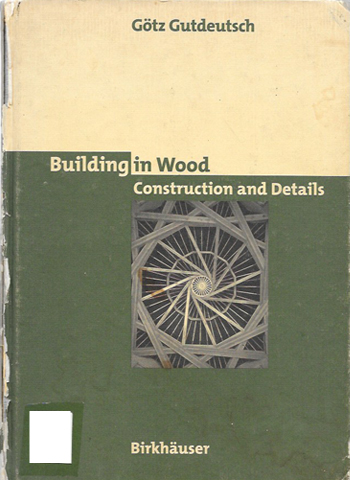Title: Building in Wood: Construction and Details
Author/s: Götz Gutdeutsch
Photographer/s: Claußen, Martin; Corneil, Carmen; Corneil, Elin; Dietrich, Richard J.; Führer, Reto; Gilbert, Denis; Heinmetz, Olav; Henz, Hannes; Kandzia, Christian; Kossakowski, Eustachy; Kulmer, Baufirma Hubert; Lamb, René; Lim, Jimmy; Lindman, Åke Erikson; Meuser, Hubert; Naito, Hiroshi; Nemec, Georg; Purkarthofer, Hans; Rosselli, Paolo; Schaudt, Herbert; Steigerwald, Bernd; Testelin, Xavier; Tzschätzsch, Manfred.
Photographs courtesy of: Arup Journal; Bauhandwerk; Behnisch & Partner, Freie Architekten BDA; Blumer AG; Brunow & Maunela Architects; Calbucci Photo Gallery; Christoffersen ApS; Detail; Dezsö Ekler Épitész KFT; EGB Betschart; Geier + Geier; Ing. Walter Dürschmid; Iwona Buczkowska; Jeremy Dixon & Edward Jones, Architects; Johansson & Uppling Arkitekter AB; John V. Mutlow; Kazuhiro Ishii Architect & Associates; Maria and Bernhard Zurbuchen-Henz; Nacása & Partners; Naito Architect & Associates; Nakao Serizawa Architects; Plan-Kreis Heinrich & Breiner Ges.m.b.H.; Prof. Thomas Herzog; Rolf Disch; Schaudt Architekten BDA; Studio Tecnici Associati; Tegnestuen Vandkunsten; Walter von Lom & Partner; Wey Elementbau AG.
Design: Martin Schank
Translation: Philip Lupton, Gerd Söffker, Philip Thrift.
ISBN: 0-8176-5277-9
Size: 216mm by 301mm, 152p.
Publisher: Birkhäuser
Publisher www: http://www.springer.com/birkhauser

Though published twenty years ago, Building in Wood: Construction and Details by Götz Gutdeutsch is a remarkable and insightful book to read today. Many of the projects shown within its pages are built using materials or techniques that have not been embraced by the construction industry of today, but there is a highly pleasant juxtaposition between the houses with that are built in a recognizable fashion and those that are not, showing the ways in which architecture have evolved over time to favour certain techniques/materials over others.
This book examines 26 separate structures from multiple countries around the world, ranging from European countries such as England, France and Austria to the Far East with Japan and Malaysia. The focus is wide enough to cover the variety of building methods, construction materials and architectural styles that the different countries offer, but there are sufficient examples from each country to show how different architects enact the building traditions of their homelands.
The major strength of this book is the authority with which Gutdeutsch speaks. The large number of photos of structural details, blueprints, floor plans and other technical drawings sourced from the architects, engineers and builders of the structures show exactly what he wants to convey, and the images are backed up by excellent commentary on the design and the building process. Credit must go to the translation team of Philip Lupton, Gerd Söffker and Philip Thrift, as the English translation brilliantly recreates the original words of Gutdeutsch.
Almost every structure that Gutdeutsch has included in Building in Wood is worth examination due to the level of detail that he puts into each one. For example, the Darwin College Study Centre, Cambridge (13) is a connecting structure in a highly populated area that was built overhanging the River Cam out of fresh felled oak, leading to a carefully thought out solution that took the necessary drying-out period into account. The Tennis Hall in Bad Waltersdorf (41) uses a barrel vault patented in the 20s to great effect and still sees much use today, creating a beautiful diamond pattern that also is extremely strong structurally. The Seiwa Puppet Theatre (79) has an incredible square-beam stacked roof within the theatre and, in the attached exhibition hall, creates an equally attractive optical effect with a circling beam design that is as complicated structurally as it is graceful in appearance.
The public buildings examined above are all spectacular, but Gutdeutsch does not pass over smaller residential builds that, while their structures may not be as grand and innovative as those of larger public buildings, still showcase the qualities that wood has over other materials. Take the Weekend House from Osaka (119); the stateliness, presence and sheer beauty of this weekend house is incredible, and there can be no greater example of how wood can be so beautiful as a structural material than in its entirely wooden interior.
The above examples have all been fairly standard buildings despite the occasional interesting choice in material or method of construction, but there are a number of particular innovative structures. The most obvious of these is the “Heliotrope” Solar-Energy House in Germany (127). This cylindrical tower house has one side covered in windows to promote high energy transference and the other side built with high thermal insulation. This, combined with an ingenious rotation system, allows the house to rotate in order to present the appropriate face to the sun; when the weather is cooler the windows can warm the entirety of the interior and, in the warmer months, uncomfortable heat and glare can be absorbed by the opposite side of the tower. The most surprising fact about the structure of this building is that it is almost entirely wood, making the structure highly sustainable even with the technical nature of the rotational technology.
Building in Wood is not a recent publication and doesn’t showcase the most recent advances in building technology or design traditions. That being said, Gutdeutsch’s level of expertise combined with the large number of photos and diagrams taken during the construction process for each building makes the case studies included in the book as detailed as they could possibly be. Building in Wood is an extremely valuable text for this reason, and for the insight that it grants into the building processes of an earlier time.
